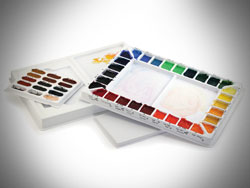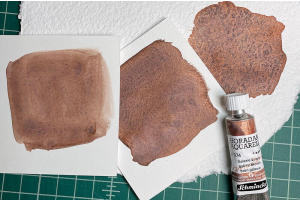We use cookies to make your experience better. To comply with the new e-Privacy directive, we need to ask for your consent to set the cookies. Learn more.
Cheap Joe’s Art Stuff Art Blog
Tips, Tricks, Thoughts, and inspiration from across the art spectrum.
In Search of the Perfect Palette

Palettes are very important accessories for artists. This is where your paints live and come alive, ready to burst onto your canvas! Unfortunately, your paints can also meet their untimely demise here as well. Given the right conditions, a palette can save you lots of money by preserving your paints for the longest amount of time possible; and the choice of palettes is enormous. There are specific palettes for oil painters, acrylic artists, and watercolorists, so how do you choose?

To begin, let’s look at palettes for oils. There are two basic palettes for oil painters, the traditional wooden palette, like the ones Monet and Renoir used hundreds of years ago, and also the current choice of disposable paper palettes. The traditional oil palette, still used today, is basically a thin wooden panel, usually shaped in an oval or rectangle with a cutout for your hand and thumb to provide a comfortable “handle”. This will allow you to rest the large palette against your side while painting. Ranging in size from roughly 5″ x 7″, up to larger sized palettes of 18″ x 26″, these wooden panels can get rather heavy while painting extended lengths of time. The raw surface is thoroughly conditioned with several coats of linseed oil before using, to seal the palette for easier mixing and clean up. The oil paints will then stay moist on the open palette for weeks without drying up. An oil palette is rarely cleaned off during the course of completing a painting, which can take months. This type of palette can be and usually is used over and over for several years without replacing making it very economical.
The second type of palette for oil painters, disposable paper palettes, definitely has its advantages. The specially coated disposable palette paper is very convenient and inexpensive to use. The coated paper is designed to keep the oils from leaking through the pad. It comes in tape-bound pads as well as individual sheets giving you the option of using it on the pad, mounted on a panel, or in a shallow plastic box. Personally, I like using the paper on the pad. If I run out of space for mixing, I just take the paper off and start another. When the painting has been completed, the palette sheet is thrown away! No mess, no cleanup. Just be sure to properly dispose of any unused oil paint. There are also shallow boxes with lids that are designed to be used with these disposable palettes. So you can cover your paints from day to day avoiding the contamination of dust and debris. Mastersons makes a series of palette boxes; the Pro Palette is just one, which includes a sponge sheet, along with sheets of coated paper to extend the life of most paints. The moisture in the sponge creates humidity inside the box which keeps the paint from drying out too quickly; usually long enough to complete a painting. This also keeps your cat from tracking your oil paint across the living room carpet! These are not airtight and the paint will eventually dry out even when kept in the box.

Disposable palettes and palette boxes are also ideal for acrylics, even more so, because they tend to dry out within hours, not days. Acrylics seem to be the most difficult medium to keep wet. However, their quick-dry quality does keep them very popular with today’s busy artists. There are other options for palettes available for acrylics, such as the glass or porcelain palette and the peelable plastic palette. These palettes provide easy cleanup with just a spray or two of water on the hardened paint. After wetting, the dried paint becomes pliable and is easily scraped off with a paint scraper or blade. The plastic peelable palette also preserves the paint longer and provides easy clean-up with both acrylics and oils as well. Some artists may see heavier glass palettes as being a disadvantage; however, they are especially great for studio use, because they will not move when you are mixing as will their lightweight cousins, the plastic palette.
There seems to be a larger more difficult selection of palettes for the watercolorist. There are plastic palettes, porcelain palettes, cup palettes, travel palettes, butcher tray palettes, spectrum palettes, piggyback palettes and there’s even a possum palette! They come in all sizes and shapes, lid or no lid, leakproof and even one called the bulletproof palette. Some of the best names in watercolor have their own palettes for which you can purchase for yourself. John Pike, Stephen Quiller, Frank Webb, Tom Lynch, Robert Wood, Sterling Edwards, Skip Lawrence, and even Cheap Joe has his own, called the Cheap Joe’s Piggyback Palette. All of these guys seem to have an idea of which is the best design to use. These reflect their preference but ultimately the choice is up to you, the artist.
Things to consider when selecting a palette… ask yourself these questions:
- Studio or Travel (Plein Air)?
- Few colors or many?
- Lightweight or heavy?
- Plastic or Porcelain
- Deep wells or Shallow?
- Single mixing area or divided?
- Standard brush width or big brush width
- Lid or not, airtight or not?
If you are working in your studio most of the time, you’ll probably want a full sized palette with many wells to allow you to add colors. You might want a lid and you could choose plastic or porcelain. Plastic palettes are lightweight and sturdy but not indestructible. They come in many designs to suit many needs. Big well palettes that accommodate larger wash brushes, closed well palettes that prevent paints to seep into the mixing area, round format palettes that mimic the color wheel for easy color selection, there’s a palette for everyone! The biggest complaint about plastic palettes is that some pigments will stain the surface. There is really no way to avoid this problem. You can scrub and sand the surface but it will continue to stain. With this in mind, plastic palettes may need replacing from year to year. They are very affordable and cost effective, and are easily transported from home to the classroom. Porcelain may be best suited for studio use. These are stain resistant and easy to clean; however, they weigh about 5-8 lbs. Not something you want to have to hold for hours or travel back and forth to class with. But on a sturdy work space, they do quite well. Porcelain palettes are fragile, they will break. No one wants to face the ordeal of having to clean up a broken palette.

When filling a new palette with fresh paint, it is recommended that you fill the wells completely around the edges and at least half full deep. This allows the paint to stay moist longer. As the top dries, it creates a skin, leaving the inside wet and ready to reactivate more quickly each time you paint. Mixing a few drops of Gum Arabic in the fresh paint will help them to dry semi moist state, so that they can rewet faster as well. The paint will eventually dry out completely; however, the paint will be fresher for a longer time between paintings. You have to keep in mind, though, the possibility of molding. Preventing mold from growing in your palette can be a problem. This happens when the palette environment is too humid and warm and creates the perfect surface in which to grow mold. It is important to keep your palette covered with a lid; this will allow air to circulate inside while protecting it from dust and bacteria. If you do experience mold growth, you can removing the mold by wetting the paint with water and swabbing the surface with an old brush. Then try cleaning the palette surfaces with a paper towel damp with a bleach and water solution. This may remove any traces of bacteria that may still be on the surface.
If you are a traveler, a studio palette would not be very convenient or lightweight, for that matter. Plein Air painters usually travel light, with limited colors, brushes and maybe a small pad of paper or a journal. Travel palettes come in many styles. The most popular is the folding palette that gives you lots of mixing space and doubles its size when fully opened. These palettes usually come with a thumb ring on the bottom that allows you to anchor the palette with your thumb for easier handling. They will also hold smaller amounts of paints, but are compact and great for short painting trips. Some travel palettes are designed to be carried in your shirt pocket. They may be just bigger than a credit card, but all the basics are on board. These are great for field studies and journal entries, or when you just need a little splash of color. It’s a great idea to store one of these compact studios in your car, boat, or backpack, so they are always handy when you are inspired to capture a scene.
Who knew there were so many things to consider when picking out a palette? There are so many choices! No matter if you are in a studio or outside, finding the perfect palette for you and your type of media is one of the most important choices you will make when selecting your painting supplies. It takes a little time and thought; however, it is worth it. We usually find out too late about a bad choice; like after we have filled the wrong palette with all of our expensive paints! Don’t be in such a hurry to get started that you don’t make a good choice when selecting your palette. It will be a choice you’ll have to work with for a long while!
Happy Perfect Palette Day!







